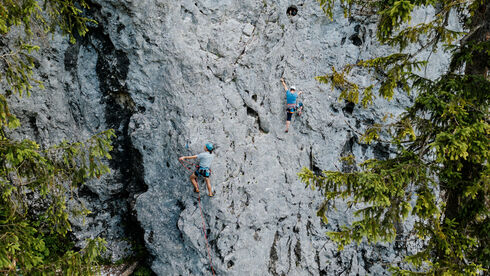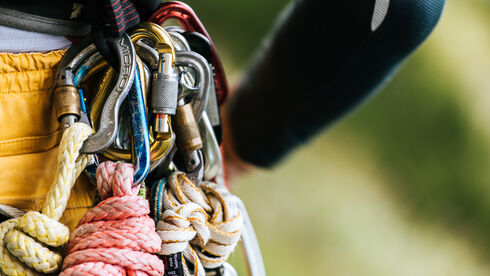Essential climbing knots
Working with rope is a fundamental skill for mountain climbing. We joined the annual Achensee climbing camp and learned the basic knowledge of climbing knots. In this article and accompanying videos, we share the most common knots used in climbing.
Tie-in knot: Double figure eight knot
The "double figure eight knot" is one of the most common knots in climbing. It’s the easiest and fastest knot for tying the rope into your harness.
How to: Tie a single figure eight knot in the rope from its end (leave some length of rope). Pull the end of the rope through the loop of the harness and follow the course of the "figure of eight" again.
- Mostly used for: Tying the climbing rope into your harness
- Pros: Quick and easy to tie, easy to control
- Cons: Difficult to undo when loaded

Tie-in knot: Double bowline knot
The "double bowline knot" is more difficult to tie than the figure eight knot but easier to untie after taking falls.
How to: Feed the rope through the tie-in points on your harness and form a loop directly above your body/harness. Pull the part of the rope underneath upwards, form a "U" and put it through the loop. This creates a new loop through which you pull the other end of the rope. For the double bowline, follow the whole course of the knot with the end.
- Mostly used for: Tying the climbing rope into your harness
- Pros: Easy to untie after taking a load
- Cons: The double bowline is harder to control than the figure 8 knot

Safety & rappelling knot: Munter hitch (HMS)
Every climber knows how to tie a munter hitch. It’s easy to tie and can be used to belay or rappel.
How to: Hold the rope in both hands, form a loop with the right end of the rope coming out at the bottom. Place the lower length of the rope on the loop forming a second loop. Clip a locking carabiner through both loops and tighten the rope.
- Mostly used for: Protecting climbing partners
- Pros: High braking effect, gentle on material
- Cons: High concentration is necessary when belaying

Safety & rappelling knot: Prusik knot
Prusik knots are most commonly used for abseiling because they are very secure when loaded. Always take a climbing cord with you.
How to: Take the climbing cord (ca. 50 centimetres) and tie it at the ends with an overhand bend (see next knot) to make a loop. Put the cord in the middle under the climbing rope and place the end of the loop over the climbing rope. Feed the end of the knot between the climbing rope and the cord (girth hitch). Then pass the cord around the climbing rope again and pull it tight.
- Mostly used for: Safety back-up knot for abseiling
- Pros: Tightens under load (additional safety measure)
- Cons: None

Joining knot: Overhand bend
The overhand bend is very easy to tie and allows you to join two half ropes. It’s very useful when you need to leave the wall quickly or if you need to cross large crevices.
How to: Hold both ropes parallel, form a loop, pass the ropes through from bottom to top and tighten.
- Mostly used for: Joining two half ropes to retreat from the wall quickly
- Pros: Easy to tie, useful to extend ropes
- Cons: None




